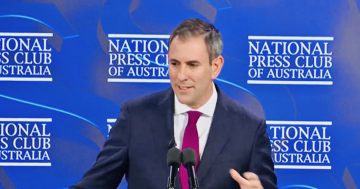
Treasurer Jim Chalmers: by 2063, health, aged care, the NDIS, defence and interest payments will account for half the federal budget. Photo: Supplied.
By 2063 about 9 million Australians will be aged 65 and over, but fewer will be relying on the pension or other government-funded income support.
Pension payments are projected to shrink from 2.3 per cent of gross domestic product to 2 per cent of GDP by 2063, thanks to more Australians taking advantage of healthy superannuation funds.
The Intergenerational Report (IGR) being released by Treasurer Jim Chalmers today (24 August) paints a picture of the next 40 years and predicts increasing pressure on the federal budget.
More money will be spent on health, aged care, the NDIS, defence, and interest payments on debt (those areas together accounting for half of Commonwealth spending by then), but proportionately less on the aged pension.
The proportion of people receiving the aged pension is predicted to be down 15 per cent from what it is today because superannuation balances will jump from 116 per cent of GDP today to 218 per cent 40 years from now.
People retiring in the mid-2040s will have accumulated superannuation payments for their entire working lives.
Over the next four decades, Australia’s tax base will markedly change, with huge drops expected in fuel excise and the number of Australians aged 85 and over expected to more than triple.
There will be about 13.8 million more people calling Australia home, with the population predicted to rise to 40.5 million by 2063, but a low fertility rate and increased life expectancy will give Australia a much older population.
The nation’s population, however, will grow at a slower rate over the next four decades than in any previous 40-year period.
Australia’s population growth will slow to 1.1 per cent.
The IGR presents a trajectory over four decades of government payments and receipts and population trends.
“The age pension is among the Australian government’s largest spending programs, and this trend will contribute significantly to the sustainability of the budget,” an excerpt of the report says.
“Superannuation tax concessions as a proportion of GDP are projected to increase from around 1.9 per cent in 2022–23 to 2.4 per cent in 2062–63.”
Dr Chalmers said the IGR will highlight the critical role of competition in revitalising productivity growth.
“Greater competition is critical for lifting dynamism, productivity and wages growth, putting downward pressure on prices and delivering more choice for Australians dealing with cost-of-living pressures,” the Treasurer said.
“Australia’s productivity growth has slowed over the past decade, and reduced competition has contributed to this – with evidence of increased market concentration, a rise in markups and a reduction in dynamism across many parts of the economy.
“We need to ensure our competition policy settings are fit for purpose in the face of the big shifts underway in our economy so we can make the most of digitalisation, the growth in services and the net zero transformation while supporting our nation’s most vulnerable.”
The Federal Government is undertaking a review of competition policy settings to help build a more dynamic and productive economy.
The review will examine competition laws, policies and institutions to ensure they remain fit for purpose, focusing on reforms that would increase productivity, reduce the cost of living and boost wages.
A competition taskforce has been established in Treasury to conduct the review, which will be progressed over two years and involve targeted public consultation.
The Treasurer said the taskforce will provide continuous advice rather than a formal report so progress can be made over time.





















